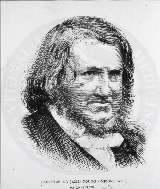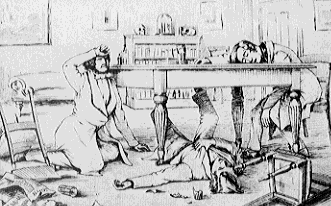A growing number of health professionals and patient
advocacy groups are pressuring doctors to change their attitude about what
is appropriate medication for chronic pain. The debate about proper pain
management was recently brought to the fore by a commission which accredits
health care organizations and which has adopted new standards for evaluating
and managing pain - in effect loosening the controls and increasing medication.
In a subsequent DoctorInternet column, the details of those new standards
will be covered; but here the focus will be on some historical background
about pain and suffering. It is an interesting tale and will give a better
understanding about some of the subliminal attitudes that may be operative
in this issue.
The use of artificial methods for pain relief in drastic
medical procedures, such as surgery, seems to have never received any moral
opposition throughout history. Wine and beer in large amounts could anesthetize;
and various plants such as henbane, mandrake, hemp, and opium were used
in various concoctions in virtually every culture. Even knock-out blows
to the head may have been used in surgical operations. In 1536, Paracelsus
described "laudanum", an alcoholic tincture of opium, for pain,
and soon thereafter, Valerius Cordus described "sweet oil of vitriol"
or ether, which, some 300 years later, was demonstrated by William Morton
(1846) to be a scientifically effective anesthesia for surgery - thus, initiating
the modern science of anesthesiology. However, the artificial relief of
pain to mitigate suffering has been another issue, and the aspect of its
morality has played a powerful role in governing the medical use of analgesics
even into the current discussion.
The word "pain" is derived from the Greek
word for payment, penalty, and punishment; and "suffering" is
the generic term for everything that produces the feeling of pain. Thus,
one can see, embedded in the concept, the notion that a person's suffering
and pain are due to some wrong for which one is being punished; and in Judeo-Christian
theology, suffering is integral to salvation. Of course, one of the mandates
of medicine is to eliminate suffering; thus, a confrontation between religion
and science is inevitable.
The landmark case in this confrontation involved the
Scottish physician, James Young Simpson, who was the first to used chloroform
to alleviate pain in child birth (1847). Of all the various types of pain,
child birth occupies a unique place in Western theology. Recall that in
the Biblical story called The Fall of Man (Genesis III), Eve and Adam violate
God's prohibition against eating the fruit from the Tree of Knowledge; and
because of that, God fears that they will proceed to the second tree, the
Tree of Life, and become immortal like himself. As a preemptive strike,
He expels the two from paradise giving punitive sanctions on them both.
For Eve, "I will intensify the pangs of your childbearing; in pain
shall you bring forth children." This divine curse was taken so literally
by religious fanatics that in 1591 King James VI of Scotland had burned
at the stake a gentlewoman named Euphanie Macalyane who secretly used a
remedy to relieve her pangs of childbirth. Although biblical interpretation
had change by the 19th Century, Dr. Simpson still was to encounter vehement
opposition on religious grounds for his use of chloroform in childbirth.
Simpson's discovery of the use of chloroform is an interesting tale and
warrants recitation here. The excerpt is from "Triumph Over Pain"
by Rene Fulop-Miller, 1938; pages 331-333.
Dr. Simpson determined to make immediate
trial of this fluid, and asked Duncan and Keith to supper on November 4,
1847. There were also present on this occasion Mrs. Simpson, her niece
Miss Petrie, and a naval officer who was a friend of the family. At table,
of course, there was talk of the proposed experiment with chloroform, the
three nonprofessional members of the party - the two ladies and the naval
officer - being equally keen on inhaling the vapor. "I have always
wanted to join in one of these experiments," said Mrs. Simpson to
her husband. Miss Petrie and the young naval man chimed in, and the professor
agreed that they should all try it. Thus, when the meal was over, the dinner
party was transformed into a chloroform party.
Each of the participants was handed a tumbler
containing a modicum of chloroform in the bottom. "Are you ready?"
asked Simpson. "One, two, three." He clapped his hands, and at
the same instant they all began to draw long, deep breaths of chloroform
vapor.
The effect was first noticed by Miss Petrie.
Usually a retiring young woman, she displayed ecstasy and excitement: "I'm
beginning to fly!" she shouted. "I'm an angel, oh, I'm an angle!"
Hardly had she spoken these words when her head dropped forward and she
was fast asleep.
At the same moment Dr. Keith burst out laughing.
Was it Miss Petrie's ecstasic words which had amused him? No one could
tell, but his laughter proved infectious. Dr. Duncan, Mrs. Simpson, the
professor himself, all began to laugh. They felt very happy, became extremely
loquacious, shouted loudly and roared with laughter. Only the navl officer
sat looking on, puzzled and aloof. He stared at the other's strange antics.
"What are you all so excited about?" he was on the point of saying,
but hardly had he begun to speak, in a deep bass, when his voice broke
into falsetto. Then he began to crow like a cock, which made the others
more hilarious than ever.
Next, as the joyful mood reached a climax,
Dr. Simpson leaped up from his chair and stood on his head in the middle
of the room, waving his feet in the air. Mrs. Simpson tried to get him
out of the undignified posture, but before she could reach him he fell
with a crash onto the floor, where he began to snore loudly. Mrs. Simpson,
too, was soon overpowered with sleep.
On awaking, Simpson first perception was
mental. "This is far stronger and better than ether," said he
to himself. His second was to note that he was prostrate on the floor.
Hearing a noise, he turned round and saw Dr. Duncan beneath a chair - his
jaw dropped, his eyes staring, his head bent under him; quite unconscious,
and snoring in the most determined manner. Dr. Keith was waving feet and
legs in an attempt to overturn the supper table. The naval officer, Miss
Petrie and Mrs. Simpson were lying about on the floor in the strangest
attitudes, and a chorus of snores filled the air.
They came to themselves one after another.
When they were soberly seated round the table once more, they began to
relate the dreams and visions they had had during the intoxication with
chloroform. When at length Dr. Simpson's turn came, he blinked and said
with profound gratification: "This, my dear friends, will give my
poor women at the hospital the alleviation they need. A rather larger dose
will produce profound narcotic slumber."
With the success of his "chloroform party",
Simpson immediately initiated its use in obstetrics. But, he soon met an
onslaught of religious criticism, calling his work "a Satanic invention"
and him a "shameless heretic". His fellow physicians turned on
him, labeling him an "irresponsible charlatan". Fortunately, he
was an obstinate man; and highly religious, himself. He quickly became a
biblical scholar and met each condemnation with skilled theological refutation.
During 4 years of vigorous debate, his reputation grew; and gradually the
wives of the clergy and his fellow physicians began seeking his obstetric
services. Finally, when Queen Victoria commanded her physician to give her
chloroform during the birth of her 8th child, opposition evaporated; and
Simpson was eventually given great honors and fame. On one occasion, after
receiving a commemorative from the city of Edinburgh (which only 10 years
before was prepared to condemn him) he made the following remark: "I
came to settle down and fight among you a hard and uphill battle of life
for bread and name and fame, and the fact that I stand before you this day
testifies that in the arduous struggle I have - won."
Links & Refererences
Anesthesia
and Pain History - Resources on the Internet.
Images
of Dr. Simpson from the National Library of Medicine.
|
 DoctorInternet
DoctorInternet
 James Young Simpson
James Young Simpson
 |